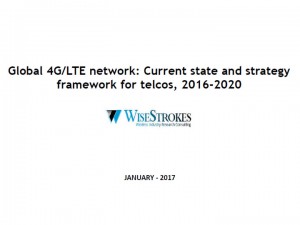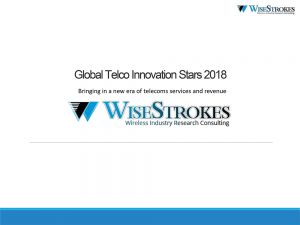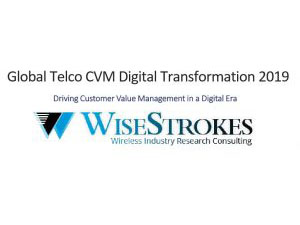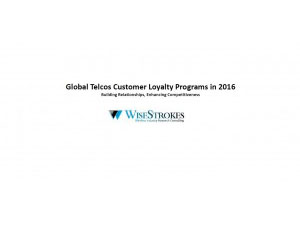$2995 – $4995
Description
Overview
The telecom operators globally are now gradually shifting their focus on delivering mobile
internet/broadband services, to balance the saturated growth there are witnessing in their
traditional voice and SMS services offerings. The operators are today facing three major
challenges namely how to manage, optimize and monetize their network and available
resources. Monetization of increased data usage has offered the opportunity to the telcos to strengthen their association with the existing customers and has provided them with a view plan to acquire new customers, and create value from these customers through enriched services experience and improved customer satisfaction levels.
The emerging regions like Asia-Pacific and African regions are the main driving factors for the increase in the mobile broadband subscribers. The growth in data services in these regions is fuelled by new subscriber acquisition whereas in the developed countries like North America and European region, the growth is owing to the delivery of high-speed internet services based on LTE, HSPA/HSDPA networks etc. The telecom operators globally are investing in deploying networks to expand their geographic reach to cover a large customer base, upgrading their
existing network to provided high speed data services to their customers & optimize the data traffic loads on the required, offering aggressive data plans to acquire and retain the customers. The increase popularity of the mobile data plans is mainly owing to availability of affordable and feature rich smartphones, availability of rich content and formats by the contents providers,increased usage of applications like Mobile Apps and OTT services (like WhatsApp, Nimbuzz etc), which has resulted in the exponential increase in mobile data traffic. The telcos owing to such a spurt in the demand have increased Capex and Opex requirements, and hence have to increase the monetization of their services offerings to increase the realization rate of the investments being made in infrastructure improvement and availability of better services.
Key Findings
The global mobile cellular subscription count is expected to equal the global population
count by the end of 2013.
The worldwide web traffic has increased by 162.7% over the period 2010-12.
It is estimated that around 309 billion apps would be downloaded annually by 2016, of which around 93% would be the free downloads.
The global mobile advertising is expected to reach $20 billion by 2016.
Commercial LTE deployments have increased from 50 across 27 countries in December
2011, to reach 206 across 79 countries in August 2013.
The global mobile data traffic is expected to reach 11.2Exabytes (EB) per month by 2017 from 0.9 Exabytes (EB) per month in 2012.
Asia-Pacific region is expected to contribute maximum to the global mobile data traffic
(around 47% of the total traffic in 2017)
Smartphones would continue to be the most popular device to access mobile internet services
Operators are adopting various pricing options like Unlimited, tiered and dynamic pricing
approaches to increase their data revenues
Target Audience
Mobile Network Operators
Mobile Software Developers
Handset and Tablet Manufacturers
Content and Applications Aggregators
Wireless Privacy and Security Specialists
Mobile Marketing and Advertising Providers
List of Contents
1. Executive Summary……………………………………………………………………………10-12
2. 2. Overview of Fixed and Mobile Broadband Market……………………….13-19
2.1 Fixed Broadband services
2.2 Mobile Broadband Services
2.3 Is Asia-Pacific a Driving factor in the increasing Mobile Broadband
subscriber growth
3. Mobile Data Services Offerings……………………………..20-31
3.1 Prime Services offerings of Telcos
3.2 Value Added Services offerings by Telcos
3.2.1. mHealth
3.2.2. Mobile Money
3.3 Network API facilitated services offered by tel cos
4. Monetization of Data Services Offerings……………………………32-61
4.1.Monetizing the mobile apps
4.1.1. Methods to increase mobile data revenues using mobile applications:
4.1.2. Ways to measure the success of mobile Applications
4.1.3. Mobile Application Scenario in Select Markets
4.1.3.1. Mobile Application in South Africa
4.1.3.2. Mobile application In China
4.2.Monetizing Mobile Videos
4.2.1. Steps involved in creation of charging model by telcos
4.3.Monetizing Mobile Banking
4.4.Monetization of Network APIs
4.4.1. Challenges in API delivery and monetization
4.4.2. Business Model options with an API
4.4.3. Ways to monetize API
4.5.Monetizing Mobile Games
4.6.Monetization by content publishers
4.7.Monetizing mobile advertising
4.7.1. Outlook of mobile advertising
4.8.Monetizing Social Network Platform
4.8.1. Benefits of Social Networking to the Telcos
4.8.1.1. Access Charges
4.8.1.2. Increased Mobile Internet Adoption
4.8.1.3. Increased Retention
4.8.1.4. Differentiation
4.8.1.5. Advertising Revenues
4.8.2. Steps carriers can take to enhance mobile social networking adoption
4.8.2.1. Introduce Flat Rate
4.8.2.2. Easy Access
4.8.2.3. Share location with location based applications and networking sites
4.8.2.4. Flexibility in Revenue Share
4.8.2.5. Directory Integration
4.8.2.6. Open to provide access to any site
5. Mobile Network and Its Monetization……………………………….62-69
5.1. Services Quality management components
5.1.1. Service offering Quality monitoring Center
5.1.2. Management of Network Traffic
5.1.3. Service quality management through device management
5.1.4. Real time network monitoring and problem resolution
5.2.Monetization in the LTE networks
5.3. Approaches for increased monetization from LTE networks
6. Challenges of data monetization…………………………………70-78
6.1.Major driving factors for Continuous growth in mobile data services
6.1.1. Increased penetration of data-enabled devices like smartphones, tablets, etc
6.1.2. Competitive and aggressive data offerings from the telcos
6.1.3. Increased penetration and adoption of new applications for various services
6.1.4. Support from the telcos through continuous investment in network capacity
6.2.Major challenges in the data services growth
6.2.1. Saturation in the traditional services
6.2.2. Threat from the substitutes
6.2.3. Specializing into other services from the core services
6.3. How to deal with the challenges to drive data revenues
6.3.1. Product attributes management
6.3.2. Differentiation of the products
6.3.3. Proactive cost management
6.4. How telcos can monetize
6.5. Is Users Personal data is the root of the next-gen business model
7. Pricing Approaches by telcos to monetize the data…………………….………79-93
7.1.Unlimited Mobile Data Plans
7.1.1. Unlimited Data plans- Some Inferences
7.1.2. Unlimited Data Plans- Does it really benefit the operators
7.1.2.1. Change in the game to acquire more customers initially
7.1.2.2. Ease of selling a customer like value proposition
7.2. Tiered data pricing
7.3. Dynamic Pricing approach
7.3.1. Will Dynamic Pricing reduce telcos woes?
7.3.1.1. Dynamic Pricing may not be suited for all emerging markets
7.3.1.2. Dynamic Planning strategy needs a pre-planning phase as well
7.3.1.3. Dynamic pricing may not always results in monetary gain
7.3.1.4. Dynamic Pricing needs to marketed and handled strategically
7.3.2. Customer’s viewpoint regarding the Dynamic Pricing
7.3.3. Critical factors for the benefits of the dynamic pricing
7.4. Defensive pricing strategies by telcos
8. Big Data and Telcos………………………………………………94-96
8.1. The Role of Analytics
8.1.1. Operational Analytics
8.1.2. Marketing Analytics
8.1.3. Ecosystem Analytics
9. Forecasts across select key regions……………………………………97-104
9.1. Factors contributing to the increase in average data usage growth:
9.2.Mobile data Revenues in Asia-Pacific Region, 2008-2016
List of Figures
Fig 1: Worldwide Population and Mobile cellular subscription growth, 2005-2013*
Fig 2: Worldwide Mobile penetration in 2013* and subscription growth rates, 2005-2013*
Fig 3: Internet users by development level, 2003-2013*, and by region, 2013*
Fig 4: Worldwide Fixed broadband penetration levels, 2008-2012/13*
Fig 5: Worldwide Mobile Broadband Subscribers and Penetration, 2013
Fig 6: Growth Rate of mobile Broadband subscribers
Fig 7: Price of mobile-broadband services, early 2013†
Fig 8: Frequency of General Mobile Internet Usage
Fig 9: Frequency General Mobile Internet Usage across various age-groups in Brazil
Fig 10: Frequency General Mobile Internet Usage across various age-groups in Indonesia
Fig 11: Frequency General Mobile Internet Usage across various age-groups in Malaysia
Fig 12: Frequency General Mobile Internet Usage across various age-groups in South Africa
Fig 13: Frequency General Mobile Internet Usage across various age-groups in UAE
Fig 14: Mobile browsing-Percentage of web Traffic
Fig 15: Worldwide Mobile Apps Stores Download Forecast, 2010-2016
Fig 16: Top 5 Revenue Generating Apps globally aggregated over August 2013 in the Apple
App Store
Fig 17: Top 5 Revenue Generating Apps globally aggregated over August 2013 in the Google
Play Store
Fig 18: Time spend on iOS and Android connected devices
Fig 19: Global Traffic growth for voice and data, 2007-2013
Fig 20: Mobile Apps Revenue and Mobile Data Revenues, 2010-2015
Fig 21: Mobile Internet usage via Apps on Smartphones
Fig 22: Time Watched by Video Length and Device
Fig 23: Frequency of watching Videos on Computer/PC
Fig 24: Frequency of Video Watching on Smartphone
Fig 25: Mobile Payment Value Chain
Fig 26: Operator and its Network Centric Ecosystem
Fig 27: Competitive moves of the players in the mobile advertising chain
Fig 28: % of Time Spent in Media vs. % of Advertising Spending, USA 2011
Fig 29: Commercial LTE deployments globally till December-2011
Fig 30: Commercial LTE deployments globally till August-2013
Fig 31: Popularity and Accessibility of Smartphones as compared to other devices
Fig 32: Smartphone usage for Social Networking (1/2)
Fig 33: Smartphone usage for Social Networking (2/2)
Fig 34: Popularity of Smartphone Price Plans
Fig 35: Popularity of Smartphone Price Plans-Brazil
Fig 36: Popularity of Smartphone Price Plans-Indonesia
Fig 37: Popularity of Smartphone Price Plans-Malaysia
Fig 38: Popularity of Smartphone Price Plans-South Africa
Fig 39: Popularity of Smartphone Price Plans-UAE
Fig 40: Mobile Internet/Data plans popularity
Fig 41: Mobile Internet/Data plans popularity across various age groups- Brazil
Fig 42: Mobile Internet/Data plans popularity across various age groups- Indonesia
Fig 43: Mobile Internet/Data plans popularity across various age groups- Malaysia
Fig 44: Mobile Internet/Data plans popularity across various age groups- South Africa
Fig 45: Mobile Internet/Data plans popularity across various age groups- UAE
Fig 46: Global Mobile Broadband Connection Forecast 2009-2015
Fig 47: Global Mobile Applications User Base Forecast 2009-2015
Fig 48: Global Smartphone Sales Forecast 2009-2016
Fig 49: Global Mobile Data Traffic, 2012-2017
Fig 50: Global Mobile Data Traffic Share by Region, 2012-2017
Fig 51: Global Mobile Data Traffic Share by Device Type, 2012-2017
Fig 52: Global Mobile Data traffic share by service type, 2012-2017
Fig 53: Mobile data Revenues in Asia-Pacific Region, 2008-2016
List of Tables
Table 1: Broadband Connections in Emerging Regions, 2011-2016
Table 2: Region wise growth in web-traffic, 2010-2012
Table 3: Mobile Apps downloads from all stores worldwide, 2010-2016
Table 4: Worldwide Mobile Advertising Revenue (in $ million) by region, 2010-2015
Table 5: LTE connections penetration across major geographies, Dec-2012-to-Aug-2013
Table 6: Summary of Per Device Usage Growth, MB per Month
List of Insights
Insight 1: Mobile data usage in the Middle East region
Insight 2: Major activities done by users on their mobile phones
Insight 3: India’s first mobile application store – Airtel App Central – clocks over 2.5 million
downloads in just 30 days
Insight 4: Blyk and Mobile Advertising
Insight 5: Airtel Kenya v/s Safaricom
Insight 6: Mobile Broadband Growth in Latin America and Smartphone subsidies
Insight 7: The 4 Gaps- The Telecom Operators Need to Address
Additional information
| User |
|---|




